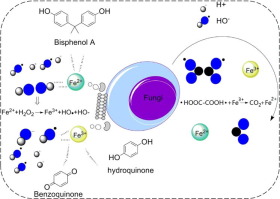Chemical Engineering Journal ( IF 13.3 ) Pub Date : 2018-01-12 , DOI: 10.1016/j.cej.2018.01.068 Chanjuan Hu , Danlian Huang , Guangming Zeng , Min Cheng , Xiaomin Gong , Rongzhong Wang , Wenjing Xue , Zhengxun Hu , Yani Liu

|
In this study, Fenton process combined with bioremediation technology, as a novel treatment technology, was applied for the removal of bisphenol A (BPA) from river sediments. The removal rate of BPA reached 58.23% after 24 days of combined treatment, which was higher than those in the treatment with Phanerochaete chrysosporium (P. chrysosporium) alone (21.59%) or the Fenton treatment alone (14.48%). The degradation mechanism of BPA in treatment process was investigated. According to the analyses of pH, iron, enzyme activities and organic acids, it was found that there was a synergetic effect between Fenton process and P. chrysosporium treatment. The organic acids generated by P. chrysosporium created a better acid environment for Fenton reaction, and the ferrous iron introduced by Fenton reagents might stimulate the development of P. chrysosporium. In addition, β-cyclodextrin (β-CD) is a good chelating agent together with excellent bioavailability, so we investigated the influence of β-CD on the combination treatment. Results showed that β-CD was able to promote the combination treatment. We also obtained that the optimal dosage of FeSO4 (270 mmol/L), ratio of Fe2+ to H2O2 and dosage of β-CD (13 mmol/L) were 0.5 mL, 1:14 (mol/mol), 1 mL, respectively. The combined treatment under mild reaction conditions provides a new way for the removal of BPA from polluted river sediments.
中文翻译:

Fenton工艺与Phanerochaete chrysosporium的组合去除河流沉积物中的双酚A:与细胞外酶,有机酸和铁有关的机理
在这项研究中,Fenton工艺与生物修复技术相结合,作为一种新颖的处理技术,被用于去除河流沉积物中的双酚A(BPA)。联合处理24天后,BPA的去除率达到58.23%,高于单独使用Phanerochaete chrysosporium(P. chrysosporium)(21.59%)或单独使用Fenton治疗(14.48%)的去除率。研究了双酚A在处理过程中的降解机理。通过对pH,铁,酶活性和有机酸的分析,发现芬顿法与金孢假单胞菌处理之间存在协同作用。金黄色葡萄球菌产生的有机酸为Fenton反应创造了更好的酸性环境,Fenton试剂引入的亚铁可能会刺激金黄色葡萄球菌的发展。另外,β-环糊精(β-CD)是一种很好的螯合剂,同时具有出色的生物利用度,因此我们研究了β-CD对联合治疗的影响。结果表明,β-CD能够促进联合治疗。我们还获得了FeSO 4(270 mmol / L),Fe 2+与H 2 O 2的比例以及β-CD(13 mmol / L)的最佳剂量分别为0.5 mL,1:14(mol / mol) ),1 mL分别。在温和的反应条件下进行联合处理为从污染的河流沉积物中去除双酚A提供了新的途径。









































 京公网安备 11010802027423号
京公网安备 11010802027423号